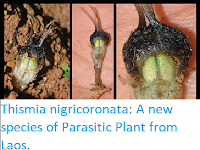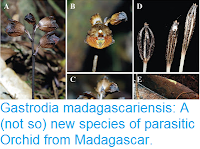Parasirism is very common in the natural world, with many species of Prokaryotic and single-celled Eukaryotic life-forms relying on the strategy, Fungi frequently parasitising Animals, Plants and other Fungi, Animals parasitising other Animals and Plants, and Plants parasitising both other Plants and Fungi. However, Plants, whilst occasionally directly consuming Animals (carnivory) do not generally parasitise Animals.
In a paper published in the journal Current Biology on 20 August 2018, Scott Egan, Linyi Zhang, Mattheau Comerford, and Glen Hood of the Department of BioSciences at Rice University describe an example of parasitism of Animals by Plants, a trophic interaction which they suspect, while not previously recorded, may in fact be widespread in nature.
Egan et al. were inspecting Sand Live Oaks, Quercus geminata, targetted by the parasitic Love Vine, Cassytha filiformis, in a native scrub habitat in southern Florida, when they observed that the galls (tumors induced by the action of a parasitc Animal on a Plant, in which the Animal, typically a larval Arthropod, lives, protected by the gall tissue and feeding on the fluids of the host Plant) of two parasitic Wasp species, Belonocnema treatae and Callirhytis quercusbatatoides, were penetrated by the haustoria (root like projection from a Parasitic Plant, that penetrates the tissues of the host) of the vine. This was despite the fact that the galls of these Wasps are located on the underside of the leaves, an area not usually targeted by the Vine, suggesting that this food source is actively sought out, rather than being attacked purely by chance.
(A) Cassytha filiformis Vine attaching haustoria to a leaf gall induced by the Wasp Belonocnema treatae on the underside of their host Plant, Quercus geminata. (B) Labeled graphic of Insect gall, parasitic Vine, and Vine haustoria. Egan et al. (2018).
The galls of Belonocnema treatae attacked by the Vine were on average 35% larger than those that were not, though this appeared to be driven by the Vine not attacking smaller galls, with no gall smaller than 3.5 mm in diameter, being attacked, rather than the Vine causing larger galls. Inspection found 45% of parasitised galls contained a dead and mummified Wasp, compared to just 2% of non-parasitised galls, suggesting the interaction had a highly adverse effect on the Wasps. A wider inspection of the area found the Vine was parasitising the galls of a further four species of Wasps, Andricus quercuslanigera, Neuroterus minutissimus, Disholcaspis quercusvirens, and Andricus quercusfoliatus, as well as the Gall Midge Arnoldiola atra.
See also...
Follow Sciency Thoughts on Facebook.







